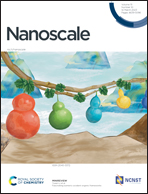Ultra-high-resolution greyscale fluorescence images via UV-exposure of thin flexible phosphor films
Abstract
Thin films of BaFCl:Sm nanocrystals prepared using a polymer binder were used to create fluorescence images. The phosphor films were exposed to a UV-C mercury lamp light source via chromium-coated quartz greyscale masks to create 4 μm resolution greyscale fluorescence images. The mechanism relies on the highly efficient conversion of Sm3+ to Sm2+ ions upon exposure to UV-C light which displays a large linear dynamic range. The red fluorescence around 688 nm of the Sm2+ is then read-out using blue-violet illumination under a laser scanning confocal microscope. The greyscale images with 16 greyscale levels had a resolution equivalent to ∼125 line pairs per mm or ∼6400 dpi. Improvements in the resolution would be possible using collimated UV-C laser exposure of the film or the use of higher resolution photomasks. Ultra-high resolution binary fluorescence images were also created with resolutions down to 2 μm (∼250 line pairs per mm, ∼12 700 dpi). Downstream applications of the technology could include tailored covert or overt anti-counterfeiting labelling.



 Please wait while we load your content...
Please wait while we load your content...